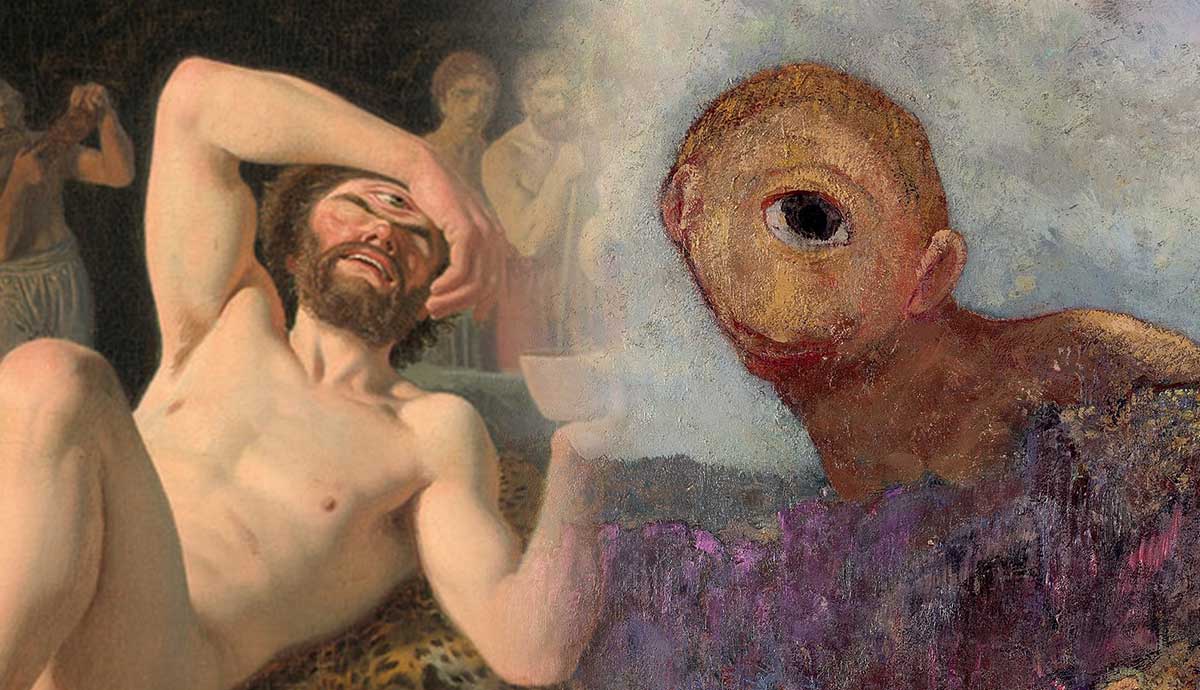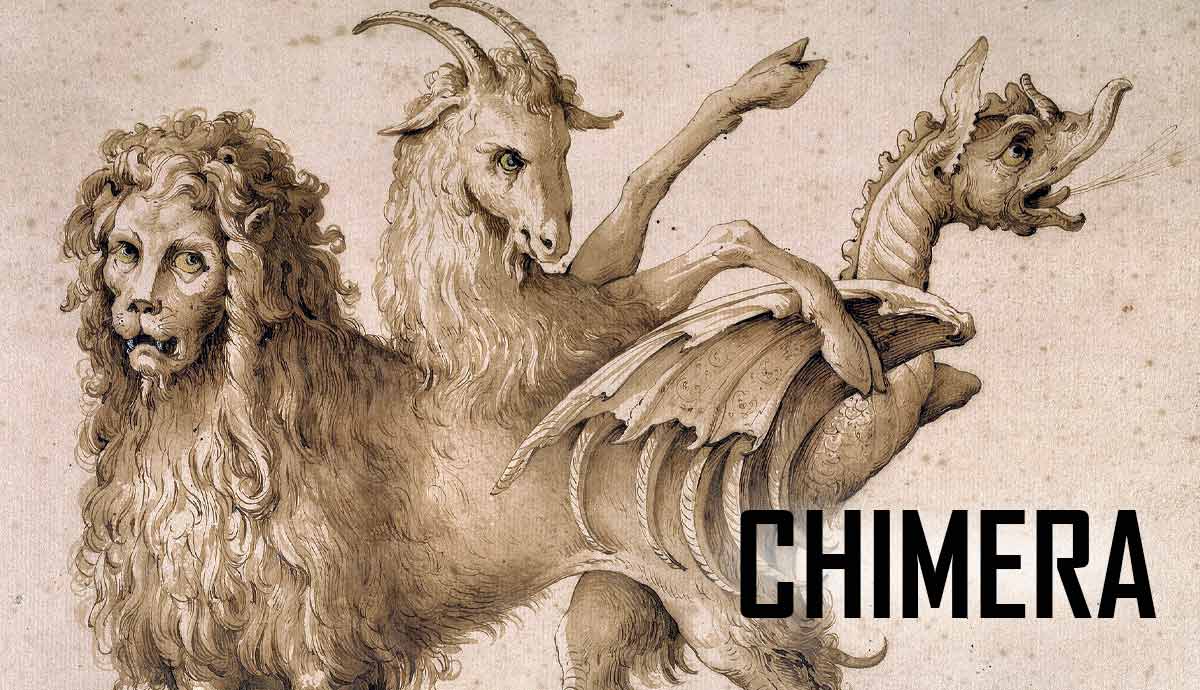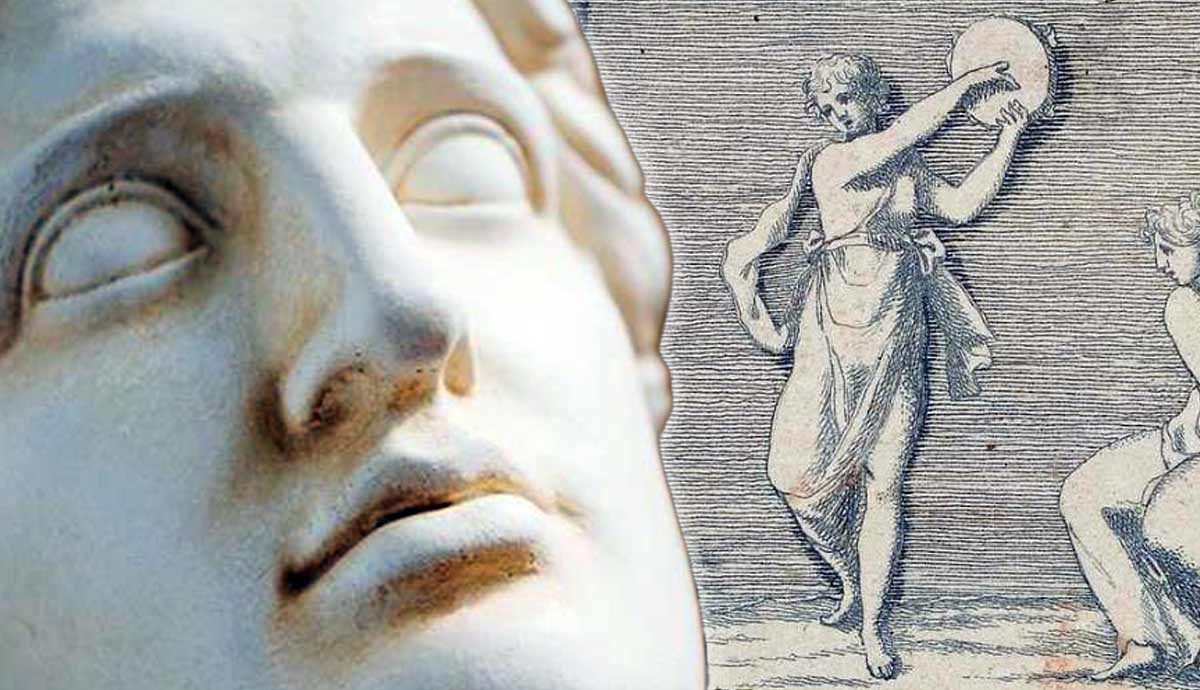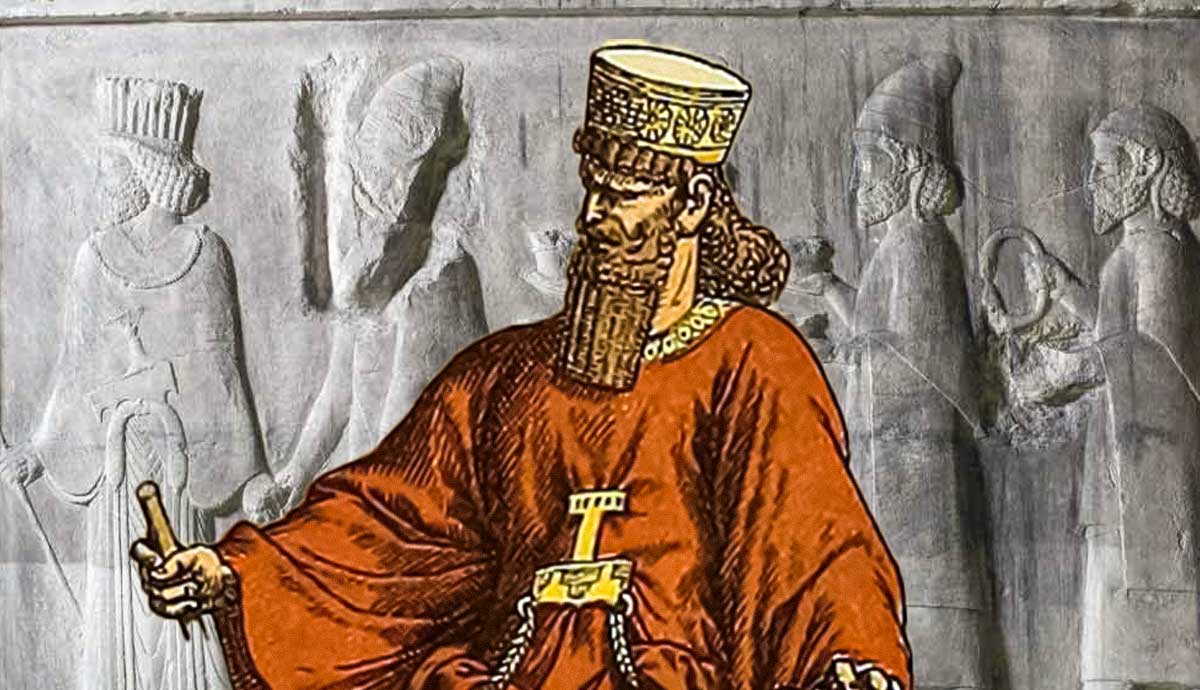
The one-eyed Cyclops is one of the most recognizable monsters in Greek mythology, but there is more to the story of the Cyclops than meets the eye. Homer depicted them as familiar, uncivilized brutes, while Hesiod described them as equals to the Titans and praised them as the original blacksmiths of the gods who forged Zeus’s thunderbolts. Cyclopes were also considered incredible builders and stonemasons who constructed the massive Cyclopean walls of Mycenae and Tiryns. Keep reading to delve into the fascinating story of these multifaceted, one-eyed giants.
What Did They Look Like?

The Cyclopes—meaning “round-eyed” or “circle-eyed”—were a group of human-looking giants described by Hesiod as resembling the Titans, except for their distinct singular eye. Modern depictions of Cyclopes show them with a single large eye instead of the typical two eyes. However, in ancient Greece, they were often represented as having an eye in the middle of their forehead, along with a human’s usual two eye sockets. These two sockets were always empty and often depicted as permanently closed eyes. While this version of the Cyclopes was the more common representation, they were sometimes described as having three eyes.
Types of Cyclopes: One-Eyed but Not One-Dimensional

Throughout history, writers have identified three distinct groups of Cyclopes. These are the Hesiodic Cyclopes Brontes, Steropes, and Arges, described by Hesiod in the Theogony as skilled craftsmen who forged Zeus’s thunderbolts; the Homeric Cyclopes such as Polyphemus, famously portrayed in Homer’s Odyssey as uncivilized, cannibalistic shepherds; and the Cyclopean wall builders, also known as Bellyhands or hand-to-mouth Cyclopes, who reportedly constructed the large stone walls of Mycenae, Tiryns and Argos that still partially stand today.
While all three groups presumably consisted of one-eyed giants possessed of supernatural strength, they differed in their origins, motives, and dispositions.
The Hesiodic Cyclopes: The Original Blacksmiths of the Gods

The earliest and most well-described type of Cyclopes is the Hesiodic Cyclopes, first found in Hesiod’s Theogony. According to Hesiod, the original Cyclopes were brothers named Arges (Bright), Brontes (Thunder), and Steropes (Lightning). Their names foreshadow their most famous creation as the smiths of light and storms—the thunderbolts of Zeus. They predated the Olympians and were the sons of the primordial gods Uranus, the personification of the sky, and Gaia, the personification of the earth. As the sons of Uranus and Gaia, the Cyclopes were the siblings of the Titans and fellow giants, the Hekatoncheiries (Hundred-Handers).
At the time of the Cyclopes’s birth, Uranus was the supreme ruler of the universe. However, like all supreme rulers in Greek myth, Uranus was insecure about his position and feared that one of his children would overthrow him. When Uranus first met his one-eyed sons, he was disgusted by their appearances and feared their immense strength. He imprisoned them and the Hekatoncheires in the depths of the earth to ensure his gigantic sons could not overthrow him.

Uranus’s imprisonment of their children was the final straw for Gaia. She convinced her son, the Titan Cronos, to usurp Uranus and free his siblings. With the assistance of the other Titans, Cronos liberated the Cyclopes and Hundred-Handers, who agreed to support him in overthrowing their father.
Cronos defeated Uranus with his siblings by castrating him and assuming control as the supreme ruler. Cronos, however, revealed himself to be just as insecure as his father. Fearing his giant brothers, he imprisoned them in the depths of Tartarus in the Underworld. Cronos seemed even more paranoid about losing his position than Uranus and set the monstrous dragon Campe to guard the Cyclopes and Hundred-Handers to ensure they never escaped.
A generation later, the Cyclopes and Hundred-Handers were freed by Zeus, a rebellious son of Cronos, after he sneaked into Tartarus and killed their guard, Campe. Zeus asked them to help him and his allies overthrow Cronos. Both the Cyclopes and Hundred-Handers agreed to help Zeus dethrone their brother. The Hundred-Handers would fight alongside Zeus in the Titanomachy (War of the Titans), while the Cyclopes took on a different but arguably more important role in the fight.

While imprisoned, the Cyclopes honed their skills at the forge and offered to create powerful weapons for Zeus and his allies to give them an edge in the battle. They forged Zeus’s thunderbolts, Poseidon’s earth-shaking Trident, and Hades’s Helmet of Invisibility. Before the war began, the Cyclopes also forged an altar upon which Zeus’s allies swore their allegiance to him and their cause. Later, the altar would be elevated into the skies as the constellation Ara. The myth explained the ancient Greek custom of swearing oaths on an altar to demonstrate good faith.
With their Cyclopean weapons, Zeus and his allies defeated the Titans and established a new regime on Mount Olympus. Although Zeus had his own insecurities about maintaining his new position, he was unafraid of the Cyclopes. As a gesture of appreciation, Zeus, the new King of the gods, invited the Cyclopes to his court and later assisted his son, Hephaestus, the new god of blacksmithing. The Cyclops brothers agreed and joined Hephaestus’s workshop within the volcano Mount Etna in Sicily.
Multiple sources report that Arges, Brontes, and Steropes had numerous Cyclops children who, like their fathers, became invaluable assistants in Hephaestus’s various workshops. With the help of their children, the Cyclopes assisted Hephaestus in creating weapons for mortal heroes and gods, including arms for the hero Aeneas, Ares’s chariot, Athena’s Aegis, and Apollo and Artemis’s bows and arrows. In Nonnus’s Dionysiaca, all three Cyclops brothers join Dionysus’s conquest of India and prove to be exceptional warriors, helping Dionysus and his army defeat their enemies.

The story of the Hesiodic Cyclopes Arges, Brontes, and Steropes, who first forged weapons from the gods, comes to a tragic and unnecessary end. Their downfall began with the emergence of a renowned doctor and son of the god Apollo named Asclepius, who introduced innovative medical and surgical techniques. With the help of Athena, Asclepius invented an elixir that could cure death itself. The new elixir angered Hades, the lord of the underworld because it prevented new souls from entering the Underworld. Hades complained to Zeus, who agreed that no mortal should be able to defy death. As a result, Zeus struck down Asclepius with one of his thunderbolts to prevent further use of the new elixir.
Asclepius’s death angered his father, Apollo, who could not enact revenge on Zeus and decided to take out his anger on the innocent Cyclopes who forged the thunderbolts. He stormed into Hephaestus’s workshop and killed the Cyclops brothers. In some accounts, Apollo killed the Cyclops brothers’ children, not them. Yet another version of the myth claims that Zeus killed the Cyclopes to prevent anyone else from gaining access to his thunderbolts.
The Homeric Cyclopes: The Uncivilized Giants of Greek Myth

The second and most well-known type of Cyclopes is the Homeric Cyclopes, first described by the storyteller Homer in his epic poem, the Odyssey, and later expanded on by the playwright Euripides in his satyr play Cyclops. While both types are defined as one-eyed giants possessing great strength, their similarities end there. While Homer never specified where they lived, Euripides placed the Homeric Cyclopes on the island of Sicily, where they dwell in caves. They were the children of Poseidon and sea nymphs such as Thoosa, the mother of Polyphemus.
The Homeric Cyclopes were brutal, impious, and uncivilized shepherds who could not perform civilized skills like agriculture, winemaking, or metalwork. They were also perceived as lawless, lacking a government, and disregarding the sacred laws of hospitality known as Xenia. They were thought to be violent and sadistic monsters, sometimes even engaging in opportunistic cannibalism. The Hesiodic Cyclopes were civilized and considered nearly equal to the gods they lived among. They were praised for their mastery at the forge and other technical crafting skills, and they were very different from the uncivilized cave-dwelling Homeric Cyclopes in almost every way.
The Homeric Cyclopes: Polyphemus

The most famous Homeric Cyclops is Polyphemus, whom Odysseus meets on his voyage home after the Trojan War. When Odysseus and his men make a pit stop in Sicily, they explore the island and discover a cave full of sheep and cheese. While Odysseus’s men suggest stealing some of the provisions, Odysseus insists on staying and meeting the shepherd who lives in the cave. Later, Polyphemus arrives and seals the cave with a large boulder, trapping Odysseus and his men inside.
Polyphemus disregards all notions of hospitality and immediately kills and eats two of Odysseus’s men and, over the next day, proceeds to devour four more of Odysseus’s crew. Odysseus then escaped by tricking Polyphemus, telling the Cyclops his name was “nobody,” and getting him drunk on strong wine. Odysseus then sharpened a stick, hardened it in fire, and used it to blind Polyphemus by stabbing him in the eye.
When Polyphemus screamed for help, none of his neighboring Cyclops came to help, as he proclaimed that “nobody” was attacking him. Odysseus and his men then escape, hiding under Polyphemus’s sheep.

Polyphemus is also featured in a very different myth concerning Galatea, the sea nymph. Galatea was a Nereid, one of the 50 daughters of the Oceanid Doris and the minor sea deity Nereus, the “Old Man of the Sea.” Galatea was considered the most beautiful of the Nereids and caught the attention of Polyphemus, who began attempting to seduce her.
Galatea was repulsed by Polyphemus’s appearance and rebuffed all of his advances. However, Polyphemus did not give up and attempted to improve himself to impress her. He tried to change his appearance and learn to play musical instruments, such as the cithara and panpipe, to seduce her. While later versions of the myth show Polyphemus successfully winning Galatea’s heart and, together, they have a son named Galas, in the early versions, she still rejects him despite his attempts to improve himself.

In an alternative version of the myth first presented by the Roman poet Ovid, Galatea falls in love with a handsome man named Acis. When Polyphemus discovers Galatea and Acis’s romance, he becomes consumed by rage and jealousy. He then rips a large boulder off the side of Mount Etna and hurls it at Acis, crushing him to death. Galatea gathers her lover’s blood and uses it to create a river starting at the base of Mount Etna in Sicily, which would later be named after him.
The Cyclopean Wall Builders: The Hand-to-Mouth Cyclopes

The Cyclopean walls of Mycenae, Tiryns, and Argos were built by a lesser-known third type of Cyclops. They were known as the Gasterocheires (Bellyhands) or the Cheirogastores (Hands-to-Mouth) because they used their hands for manual labor to feed themselves. These Cyclopes were skilled stonemasons and builders, possessing abilities similar to those of the Hesiodic Cyclopes. Both groups were skilled artisans who worked to benefit the gods and humankind. Given these similarities, it may have been the case that the two types of Cyclopes were related.
There is very little known about the Hand-to-Mouth Cyclopes. According to the ancient geographer Strabo, the mythical King of Argos, Proetus, seven Cyclopes from Lycia in southern Anatolia were brought to construct the walls of Tiryns. However, some argue they were initially from Thrace or brought to Greece by the hero Perseus from his home island of Seriphos.

The Cyclopes were known for constructing impressive fortifications in the ancient cities of Mycenae, Tiryns, and Argos. These stone walls were built using massive unworked limestone boulders that were tightly fitted together without mortar. The ancient Greeks believed that the enormous size and intricate placement of the stone boulders in the walls surpassed human capabilities in strength and skill. They thought only a creature as strong and technically skilled as a Cyclops could have built them. This unique and impressive type of stonework is known as Cyclopean Masonry. It also describes other astonishing ancient stone fortifications, such as the Cyclopean Wall of Rajgir in the Indian state of Bihar.
The Cyclopean wall builders were also credited with constructing a labyrinth in the caverns of Nauplia in the Peloponnese and a stone sculpture of Medusa at Argos. In his book Natural History, Pliny the Elder reported an account, first attributed to Aristotle, that the Cyclopes were the inventors of stone masonry towers. Pliny also praised these wall-building Cyclopes as the first to work with iron and bronze.










